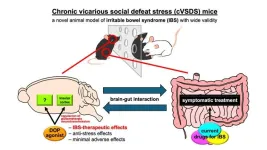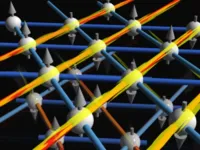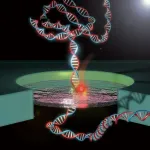(Press-News.org) New study demonstrates that certain incised stone artefacts from the Levantine Middle Palaeolithic, specifically from Manot, Qafzeh, and Quneitra caves, were deliberately engraved with geometric patterns, indicating advanced cognitive and symbolic behaviour among early humans. In contrast, artefacts from Amud Cave, with shallow and unpatterned incisions, are consistent with functional use. This research highlights the intentionality behind the engravings, providing key insights into the development of abstract thinking and the cultural complexity of Middle Palaeolithic societies.
Link to photos: https://drive.google.com/drive/folders/1yjBLQulh_uoy9mAyI3WTqvyvH9Y0IhMM?usp=sharing
A new study led by Dr. Mae Goder-Goldberger (Hebrew University and Ben Gurion University) and Dr. João Marreiros (Monrepos Archaeological Research Centre and Museum for Human Behavioural Evolution, LEIZA, and ICArEHB, University of Algarve), in collaboration with Prof. Erella Hovers (Hebrew University) and Dr. Eduardo Paixão (ICArEHB, University of Algarve), has shed new light on the behavioural complexity of Palaeolithic hominins. Published in [Archaeological and Anthropological Sciences], the research explores the intentionality behind incised stone artefacts, providing compelling evidence of abstract thinking and symbolic behaviour during the Middle Palaeolithic period.
Until now, the intentionality of Middle Palaeolithic incised stone artefacts was broadly accepted and although not well-supported by empirical testing. Many archaeologists viewed these marks as functional, created through tool use or natural wear. There was skepticism about the existence of abstract or symbolic thought in early hominins, with the understanding that symbolic behaviour, such as art or abstract expression, emerged much later in human evolution and is specifically associated with modern humans. This study challenges that view, offering evidence of deliberate, symbolic engravings prior to global colonization by modern humans.
The study focuses on artefacts from key Levantine sites, including Manot Cave, Amud Cave, Qafzeh Cave, and the open-air site of Quneitra. Using advanced 3D surface analysis, the researchers examined the geometry and patterns of incisions to distinguish intentional engravings from functional marks. The findings reveal striking differences:
Artefacts from Manot, Qafzeh, and Quneitra feature deliberate engravings with geometric patterns that align with the surface topography, underscoring their aesthetic and symbolic intent. In contrast, incisions on artefacts from Amud Cave are shallow, unpatterned, and consistent with functional use as abraders.
Dr. Mae Goder-Goldberger explains, "Abstract thinking is a cornerstone of human cognitive evolution. The deliberate engravings found on these artefacts highlight the capacity for symbolic expression and suggest a society with advanced conceptual abilities."
Dr. João Marreiros added, “The methodology we employed not only highlights the intentional nature of these engravings but also provides for the first time a comparative framework for studying similar artefacts, enriching our understanding of Middle Palaeolithic societies.”
While the engraved artefacts from Qafzeh, Quneitra, and Manot are isolated initiatives within their chronological and geographic contexts, the shared traits of the incisions themselves and the similarities in pattern structuring suggest intentional, predetermined actions. These findings deepen our understanding of symbolic behaviour and offer crucial insights into the cognitive and cultural development of early hominins.
This research marks a significant step toward understanding the scope of symbolic behavior of our ancestors, bridging the gap between functional tool use and abstract expression.
END
Ancient engravings shed light on early human symbolic thought and complexity in the levantine middle palaeolithic
2025-02-05
ELSE PRESS RELEASES FROM THIS DATE:
The sexes have different strengths for achieving their goals
2025-02-05
Many factors are needed to achieve our goals. Now researchers have looked at passion, drive and people’s ability to find flow.
“This is the first study to look at these factors together,"says Professor Hermundur Sigmundsson at the Norwegian University of Science and Technology (NTNU’s) Department of Psychology.
The researchers have found differences between the sexes. The results indicate that the sexes each have their own strengths when it comes to success.
Men are more passionate than women when it comes to achieving their goals. They also often have an easier time finding flow.
Women, ...
College commuters: Link between students’ mental health, vehicle crashes
2025-02-05
Young adults are a higher risk group for being in a crash while driving due likely to inexperience with driving, driving under the influence, and a greater propensity to take risks while driving. Although research has explored sociodemographic links of driver crashes based on age, sex and socioeconomic status, reports on the relationship between crashes and mental health are sparse.
A new Florida Atlantic University study fills a notable gap by exploring the correlation between commuter college students’ mental health status and being in a crash while driving. Commuter students, often lower-income, older, or balancing family responsibilities, face greater ...
Using sugars from peas speeds up sour beer brewing
2025-02-05
Sour beers have become a fixture on microbrewery menus and store shelves. They’re enjoyed for their tart, complex flavors, but some can require long and complicated brewing processes. Researchers reporting in ACS’ Journal of Agricultural and Food Chemistry brewed new sours in less time using a seemingly strange ingredient: field peas. The experimental beers had fruity — not “beany” — flavors and other attributes comparable to a commercial Belgian-style sour, but with shorter, simpler brewing steps.
“Sour beer is the beer enthusiast’s alternative to Champagne. By using sugars derived from peas that yeast ...
Stormwater pollution sucked up by specialized sponge
2025-02-05
Reusable sponge platform has successfully removed oil, phosphate and metal from contaminated water
New development allows capture of valuable minerals and reuse of the sponge
Water pollution concentrations move from 0.8 parts per million to undetectable levels
EVANSTON, Ill. --- As more waterways contend with algae blooms and pollution caused by minerals from agricultural runoff and industrial manufacturing processes, new methods to remove pollutants like phosphate, copper and zinc are emerging across fields.
While solutions exist, they tend to be costly ...
Value-added pancakes: WSU using science to improve nutrition of breakfast staple
2025-02-05
PULLMAN, Wash. — Typical breakfast pancakes are soft, fluffy and delicious but, sadly, not terribly healthy.
Food scientists at Washington State University are working to change that by boosting the popular morning favorite’s nutritional value while enhancing its taste and texture.
“Generally, pancakes are made with refined flours, contributing to empty calories,” said Girish Ganjyal, a professor and food processing specialist in WSU’s School of Food Science. “We wanted to see if it’s ...
Beyond the gut: A new frontier in IBS treatment by targeting the brain
2025-02-05
Irritable bowel syndrome (IBS) is a common digestive disorder that affects the intestine, causing symptoms such as abdominal pain, bloating, gas, and changes in bowel habits, including diarrhea, constipation, or both. Although this condition affects about a tenth of the global population, the underlying causes and mechanisms of IBS remain unclear. Consequently, treatments for IBS primarily focus on managing symptoms rather than addressing the root cause of the disorder.
At Tokyo University of Science ...
New spin on quantum liquids: Quasi-1D dynamics in molecular spin systems
2025-02-05
Quantum spin liquids (QSLs) are fascinating and mysterious states of matter that have intrigued scientists for decades. First proposed by Nobel laureate Philip Anderson in the 1970s, these materials break the conventional rules of magnetism by never settling into a stable magnetic state, even at temperatures close to absolute zero. Instead, the spins of the atoms within them remain constantly fluctuating and entangled, creating a kind of magnetic “liquid.” This unusual behavior is driven by a phenomenon called magnetic frustration, where competing forces prevent the system from reaching a single, ordered configuration. QSLs are notoriously ...
Spinal cord stimulation restores neural function, targets key feature of progressive neurodegenerative disease
2025-02-05
PITTSBURGH, Feb. 5, 2025 – A new drug-free, minimally invasive intervention targets the root cause of progressive loss of neural function in spinal muscle atrophy (SMA), an inherited neuromuscular disease. An intervention, which involves electrical stimulation of the sensory spinal nerves, can gradually reawaken functionally silent motor neurons in the spinal cord and improve leg muscle strength and walking in adults with SMA. The findings were reported by University of Pittsburgh School of Medicine researchers in Nature Medicine today.
Early results from a pilot clinical trial in three human volunteers with SMA show that one month of regular ...
Shut the nano gate! Electrical control of nanopore diameter
2025-02-05
Osaka, Japan—A gate that can be open or shut to allow or block the passing of species on one or both sides applies not only on the macroscale, for example a farm gate used to control stock movement, but also at the nanoscale, where a gate can control the translocation of single molecules.
A collaboration headed by researchers at Osaka University has developed a nanogate that can be open or shut by applying electricity. The nanogate shows various behaviors depending on the materials in the solutions on both sides of the gate and the applied voltage, making it attractive for different applications including sensing and controlled chemical reactions.
The ...
Cutting emissions in buildings and transport: Key strategies for 2050
2025-02-05
Key findings: a roadmap to transform energy use by 2050
Electrification (e.g., switching to electric vehicles, heat pumps) alone could cut direct emissions by 45-77% in buildings and 22-86% in transport by 2050.
Combining electrification, efficiency improvements, and behavioral changes could reduce emissions even further: 51-85% for buildings and 37-91% for transport by 2050.
A multi-strategy approach would lower overall electricity demand by 8-33% per year, making the transition more cost-effective ...








